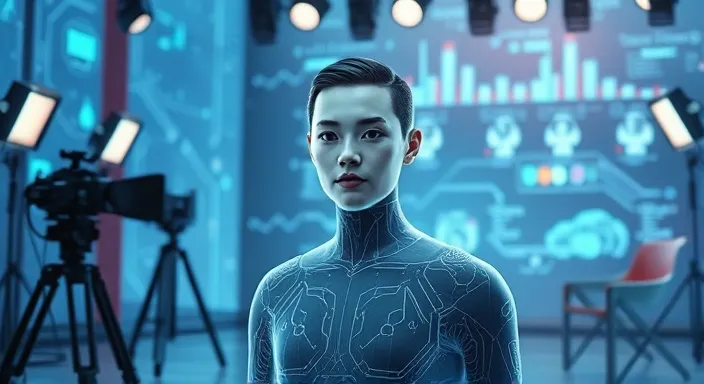The entertainment industry has been transformed by the latest innovation in virtual actor AI over the past years. Artificial intelligence has advanced digital personas beyond static, robotic performances and now delivers nuanced, lifelike acting. Virtual actors AI is reshaping how movies, games, advertisements, and even live events are created with unprecedented creative possibilities and efficiency.
What Are Virtual Actors AI?
Virtual actors AI represents digital humans or fictional characters in artificial intelligence. These entities of AI are empowered to mimic expressions, emotions, and behaviors; they can do this to make their performances credible as a traditional actor would. Virtual actors AI is not like traditional CGI characters since these use deep learning algorithms in order to modify and adapt to diverse inputs, hence making them more flexible and, most importantly, more realistic.
Key Features of Virtual Actors AI
- Emotion Simulation: Algorithms allow the realistic representation of happiness, sadness, anger, and surprise.
- Voice Synthesis: Advanced voice AI creates natural-sounding dialogue with correct tones and intonations.
- Real-Time Interaction: Virtual actors can interact with live audiences in real time or adapt their performances based on the performance.
- Customization: Creators can create customized virtual actors for a particular production to ensure a uniform look across productions.
Virtual Actors AI Applications
Artificial intelligence is being applied to different sectors, each benefiting from its use.
1. Movies and Television
Change the process of film and television production. They can:
- Perform supporting or even leading roles without physical restraints.
- Replicate performances of deceased actors for nostalgic or plot purposes.
- Lower the cost of productions by avoiding traveling, makeup, or costume needs.
2. Gaming
In the gaming sector, virtual actor AI brings characters to life through:
- Realistic interactions between players and non-player characters (NPCs).
- Adaptive behaviors that respond to player actions, enhancing immersion.
- Endless possibilities for creating rich, dynamic storylines.
3. Advertising and Marketing
Brands are utilizing virtual actors and artificial intelligence for:
- Personalized ad campaigns that speak directly to the target audience.
- Cost-effective solutions for creating high-quality promotional content.
- Consistent brand mascots capable of evolving with the company.
4. Education and Training
Virtual actors are changing the educational landscape with
- Simulation of real life for training
- Virtual tutorship for every learner
- Interactive storytelling as a way to engage
5. Live Events and Virtual Influencers
From concert performances to social media, virtual actors make their mark with
- Host live events free from the logistics of real performers
- Develop virtual influencers and connect with fans across the world
- Allow fan interactions by AI-driven meet-and-greet sessions
Advantages of Virtual Actors AI
Virtual actors artificial intelligence advantages include:
- Cost Efficiency: no costs associated with actors, traveling, and stay.
- Creative Freedom: the chance for directors to experiment with unique ideas without limitations of the body.
- Time-saving: faster turnaround times for filming due to limited reshoots and retakes.
- Global Access: Allow creatives to work on multilingual content.
- Reduce carbon footprint
Challenges of Virtual Actors AI
While its promises are many, virtual actors artificial intelligence also brings some of its challenges:
1. Ethical concerns
- Technology can be abused for nefarious purposes, creating fake news and impersonations, among other things.
- The real actors or the public figures involved in the process raise intellectual property rights and permission issues.
2. Technical limitations
- The processes entailed in coming up with these complex AI models are very costly.
- Specific nuances of human behavior cannot be captured.
- Uncanny valley effect: Virtual actors are seen as strangely unnatural.
3. Industry Resistance
- Job loss for traditional actors.
- The audience is not willing to accept virtual characters completely.
Future of Virtual Actors AI
The future of virtual actors AI is bright with the advancement of technology. Some possible developments are:
- Hyper-Realistic Avatars: Higher realism with better skin textures, facial expressions, and body movements.
- AI Collaboration: Interoperability with other AI systems for smooth storytelling and content generation.
- Ethical Frameworks: Industry standards for the responsible use of these technologies, with ethical concerns.
Conclusion of Virtual Actors AI
Virtual actors are no doubt the new game in the entertainment industry and beyond. These digital performers blend the most cutting-edge artificial intelligence with creative storytelling, thereby opening a whole world of opportunities. Constant improvement and best practices can surmount challenges. With AI evolving further, the scope of imagination and technology will be bound forward to mark a new beginning in digital entertainment.
Read Also: The Future of Interaction: Virtual Reality AI Roleplays Explained
FAQ Section of Virtual Actors AI
Artificial intelligence-powered digital characters can perform tasks that have traditionally been done by human actors. They simulate emotions, expressions, and behaviors, making them versatile for films, games, advertisements, and more.
Virtual producers can use AI virtual actors in the play-acting role, recreation of dead actors, and reduction of production costs since they are not physical actors with related logistics.
Advantages are cost-effectiveness, creativity, time-saving, access, and environmental friendliness.
Yes, there are ethical considerations, such as misuse for deepfakes, issues of consent in recreating real people, and intellectual property rights.
Virtual actors Artificial intelligence has numerous benefits, but replacing the human actor entirely is unlikely. Rather, it is an addition to traditional acting and opens up new creative possibilities.

